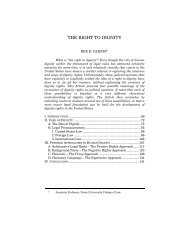A Right to Media? Lorie M. Graham - Columbia Law School
A Right to Media? Lorie M. Graham - Columbia Law School
A Right to Media? Lorie M. Graham - Columbia Law School
Create successful ePaper yourself
Turn your PDF publications into a flip-book with our unique Google optimized e-Paper software.
434 COLUMBIA HUMAN RIGHTS LAW REVIEW [41:429<br />
undesirable . . . and they have been accepted as the genuine<br />
ideological condition for consumption. Thus, the Indian not<br />
only works a month in order <strong>to</strong> buy a kilo of salt, but for<br />
three years <strong>to</strong> acquire a transis<strong>to</strong>r [radio] which places him<br />
in a situation of passive communication, as a mere receiver<br />
of the stimuli of the national society; thus . . . the more<br />
products he consumes from the outside, the more exploited<br />
he becomes. 16<br />
The Cobo Report argued that the absence of indigenous<br />
voices in mass media threatens the very existence of indigenous<br />
peoples by undermining their languages, cus<strong>to</strong>mary law, and cultural<br />
traditions, as well as effective participation in the social, economic,<br />
and political activities of the State. 17<br />
The Cobo Report also served as a catalyst for action. In 1982,<br />
a U.N. Working Group on Indigenous Populations (WGIP) was<br />
established with a mandate <strong>to</strong> develop, among other things, human<br />
rights “standards concerning the rights of indigenous peoples.” 18 The<br />
first draft of the U.N. Declaration on the <strong>Right</strong>s of Indigenous<br />
Peoples included a provision aimed at addressing the discrimination<br />
against indigenous peoples in media that had been earlier identified<br />
in the Cobo Report.<br />
Like the other articles in the draft Declaration, the media<br />
article evolved as a result of several discussions among U.N., state,<br />
and indigenous representatives. 19 In response <strong>to</strong> suggestions from<br />
16. Martinez Cobo June Report, supra note 8, para. 71 n.31.<br />
17. Part IV of this Article will discuss ways in which domestic legal<br />
systems can address these structural and cultural inequities that have been<br />
identified by the Cobo Report and other studies. Moreover, within the Cobo<br />
Report we can also find some recommendations on addressing these inequities.<br />
See Martinez Cobo Sept. Report, supra note 6, paras. 145, 461.<br />
18. Under the auspices of WGIP work on the draft declaration on the rights<br />
of indigenous peoples began in 1988. Prior <strong>to</strong> that, at its fifth session, in 1987, the<br />
WGIP adopted 14 draft principles in preliminary wording. This working paper<br />
was adopted as a preliminary draft declaration and formed the basis of what<br />
would one day become the Declaration. For a detailed chronology of the<br />
Declaration’s evolution, see ECOSOC, Sub-Comm’n on the Promotion and Prot. of<br />
Human <strong>Right</strong>s, Working Group on Indigenous Populations, Annotations <strong>to</strong> the<br />
Provisional Agenda, paras. 4–22, U.N. Doc. E/CN.4/Sub.2/AC.4/2000/1/Add.1<br />
(June 22, 2000).<br />
19. In an early iteration, indigenous peoples’ right <strong>to</strong> media was framed as<br />
“the right <strong>to</strong> the use of and access <strong>to</strong> all forms of mass media in their own<br />
languages.” ECOSOC, Sub-Comm’n on the Promotion and Prot. of Human <strong>Right</strong>s,<br />
Working Group on Indigenous Populations, annex 1 para. 12, Standard-Setting<br />
Activities: Evolution of Standards Concerning the <strong>Right</strong>s of Indigenous















